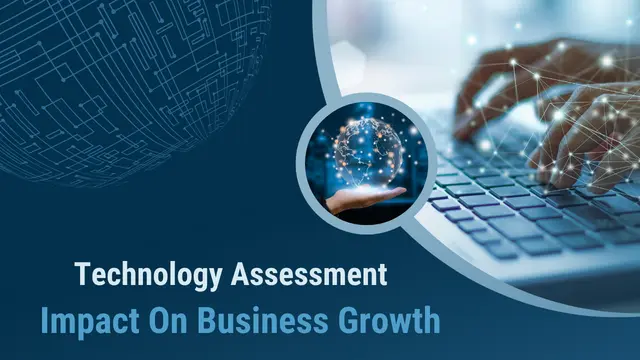
Technology drives growth and innovation in today’s dynamic business landscape. Technology assessment systematically evaluates an organization’s technological infrastructure, processes, and strategies.
This proactive approach enables businesses to identify their technological ecosystem’s strengths, weaknesses, opportunities, and threats. By leveraging IT Assessment effectively, businesses can optimize their operations, mitigate risks, and capitalize on emerging opportunities, thus fostering sustainable growth and competitive advantage.
What is Technology Assessment?
Technology Assessment comprehensively analyzes an organization’s technological assets, including hardware, software, networks, and digital capabilities. It evaluates the alignment between technology investments and business objectives, assesses the effectiveness of existing systems and processes, and identifies areas for improvement and innovation. The primary goal of tech assessment is to enhance operational efficiency, drive innovation, and ensure that technology investments deliver tangible business value.
What Is the Purpose of Technology Assessment?
The purpose of technology assessment is multifaceted, encompassing various strategic objectives aimed at driving business growth and competitiveness:
1. Optimizing Performance: By evaluating the performance of existing technology infrastructure and systems, organizations can identify bottlenecks, inefficiencies, and areas for optimization. This enables them to streamline processes, improve productivity, & enhance the overall performance of their operations.
2. Mitigating Risks: IT Assessment helps organizations identify and mitigate potential risks associated with their technological ecosystems, such as security vulnerabilities, compliance issues, and system failures. By proactively addressing these risks, businesses can safeguard their assets, data, and reputation.
3. Informing Decision-Making: Through tech assessment, businesses gain valuable insights into the effectiveness of their technology investments and strategic initiatives. These insights enable informed decision-making, facilitating resource allocation, prioritization, and strategic planning aligned with business objectives.
4. Driving Innovation: By assessing emerging technologies and market trends, organizations can identify opportunities for innovation & competitive differentiation. IT Assessment fosters a culture of innovation by encouraging experimentation, collaboration, and the adoption of cutting-edge solutions to meet evolving customer needs & market demands.
Technology Assessment Process
The technology assessment process typically involves the following steps:
1. Scope Definition: Defining the scope and objectives of the assessment, including the areas of technology infrastructure, systems, processes, and strategic goals to be evaluated.
2. Data Collection: Gathering relevant data and information through interviews, surveys, documentation reviews, and technical assessments to understand the current state of technology within the organization.
3. Analysis and Evaluation: Analyzing the collected data to assess technology assets’ performance, effectiveness, and alignment with business objectives. This may involve benchmarking against industry best practices and standards.
4. Identification of Opportunities and Challenges: Identifying opportunities for improvement, innovation, and optimization, as well as potential challenges, risks, and barriers to technological advancement.
5. Development of Recommendations: Develop actionable recommendations and strategies to address identified opportunities, mitigate risks, and optimize the organization’s technological ecosystem.
6. Implementation Planning: Creating a roadmap for implementing the recommended changes, including prioritization, resource allocation, timelines, and milestones. 7. Monitoring and Continuous Improvement: Monitoring the implementation progress, measuring outcomes, and refining strategies based on feedback and changing business needs to ensure ongoing improvement and alignment with organizational goals.
Information Technology Risk Assessment
Information technology risk assessment is a critical component of technology assessment, explicitly identifying and mitigating risks related to technology infrastructure, data security, and regulatory compliance. It involves:
1. Risk Identification: Identifying potential risks and threats to the organization’s technology assets, including cybersecurity threats, data breaches, system failures, and compliance issues.
2. Risk Analysis: Risk Analysis involves assessing the likelihood & potential impact of identified risks on the operations of the organization, finances, reputation, and compliance obligations.
3. Risk Mitigation: Developing & implementing risk mitigation strategies & controls to reduce likelihood and impact of identified risks, such as implementing cybersecurity services, disaster recovery plans, and compliance frameworks.
4. Monitoring and Response: Continuously monitor for new risks and emerging threats and implement proactive measures to address them effectively. Additionally, incident response protocols should be established to mitigate the impact of security breaches or technology failures promptly.
Technology assessment is a strategic imperative for businesses seeking to drive growth, innovation, and competitiveness in today’s digital era.

Circle MSP provides top-notch IT Assessment services for businesses that unlock the full potential of IT to achieve their strategic objectives and sustain longterm success. Contact us now to schedule the consultation and take the first step towards seamless IT operations and enhanced productivity with Circle MSP.
Frequently Asked Questions
How does an IT Assessment differ from a general Technology Assessment?
An IT assessment evaluates an organization’s information technology infrastructure, systems, and security measures. While a tech assessment may encompass a broader range of technological aspects, an IT assessment delves deeper into the specifics of IT systems and their impact on business operations.
What are the benefits of conducting a Business Technology Assessment?
A Business tech Assessment helps organizations align their technology investments with strategic objectives, optimize operational efficiency, mitigate risks, and drive innovation. It enables informed decision-making and fosters a culture of continuous improvement and adaptability.
What are the strengths of technology-based assessment?
Technology-based assessment offers efficiency through automation, accuracy via reduced human error, and scalability to handle large volumes of data. Standardization ensures consistency, while accessibility enables remote collaboration. Data visualization aids understanding, while real-time reporting facilitates quick decision-making. Customization, integration, and feedback mechanisms further enhance assessment effectiveness.
What specific Technology Assessment services does Circle MSP offer?
Circle MSP offers a range of IT Assessment services, including IT infrastructure assessment, software evaluation, cybersecurity assessment, print assessment, cloud readiness assessment, digital transformation assessment, and technology roadmap development. Our IT services are designed to meet our client’s diverse needs.
How does Circle MSP ensure data security during Technology Assessment processes?
At Circle MSP, we prioritize data security by implementing robust encryption protocols, access controls, and compliance measures. Our team undergoes regular training to maintain awareness of security best practices, and we adhere to industry standards to safeguard sensitive information.
